Review and images by JimoAi; edited by bmathison1972
There are roughly 34,000 species of fish inhabiting the World’s oceans, seas, ponds, rivers, and lakes in the present, but many more species have already gone extinct or have yet to be discovered. In recent years, many figure companies have had their fair share of fish figures, although are usually outclassed by the more popular mammals. Although it’s mostly great whites, whale sharks, manta rays, and clownfish that are the go-to species, there have been a fair share of unique species made: Safari Ltd.’s Marbled ray, Mojo Fun’s blue groper (which resembles a male Napoleon wrasse more in its appearance), as well as Kaiyodo bringing in multiple unique species like the Clark’s anemonefish, golden dorado, and the obscure parrotfish, Scarus obishime. But very few companies have matched Yujin’s variety in fish (maybe except for Colorata, who has 19 cartilaginous fish and 52 bony fish). Yujin has produced over 60+ fish species, all which are bony fish, and not including colour variants or growth stages. The first set focusing on fish produced by Yujin was made back in September 2004 and it focused mostly on fishes dwelling in and around coral reefs and, to a lesser extent, the Finding Nemo movie (which came out a year prior and more than half of the species are real life versions of characters from the movie). Because this will be a long review, I will be splitting it up into 2 parts: fish based on characters in the movie and the other reef fish. For the first part, we will be focusing on the species that are inspired from Marlin/Nemo, Dory and the fish tank gang.

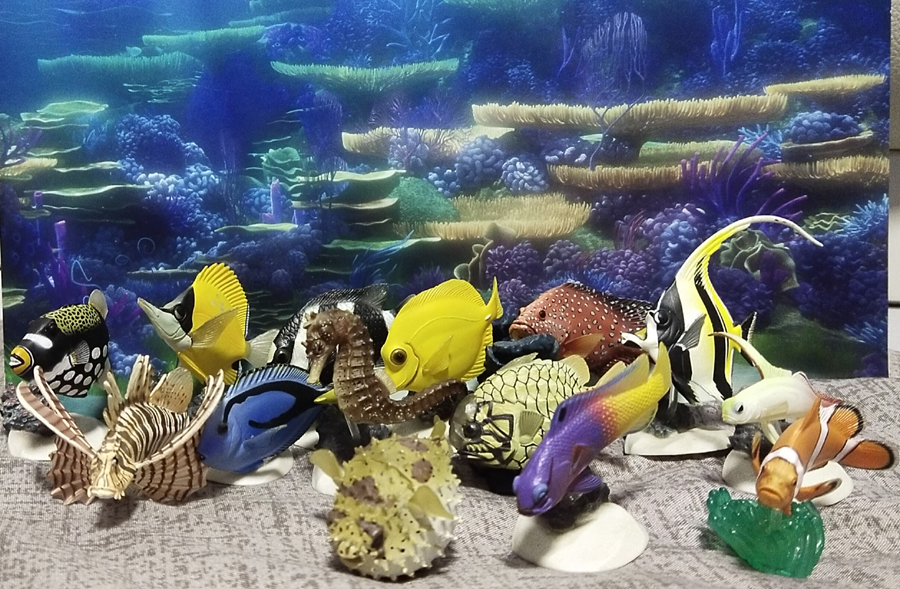
Ocellaris clownfish (Amphiprion ocellaris)
- Size of figure: 5 cm
- Size of actual animal: 5-11 cm (stated on leaflet)
- Scale: 1:1 to 1:2.2
- Color: orange body with white stripes outlined in black
- Diet: Zooplankton, algae, and undigested food from their host anemone
- Species frequency in being made into toy form: uncommon (not including figures made based on the characters Nemo or Marlin)
- Base: Anemone tentacles
- Notes: A quintessential species for all figure companies making saltwater fish figures, except CollectA, who has yet to make a clownfish. The figure has many tiny details many figure companies left a blank eye on: the correct number of dorsal fin rays (10), sculpted nostrils and translucent fins; alhough to be fair, alot of fish figures made by Japanese companies are sculpted on translucent plastic. This is the only figure to have a translucent green anemone base, although there is a white one available too. Like the majority of the figures, this figure is attached by a translucent acrylic rod to the base.
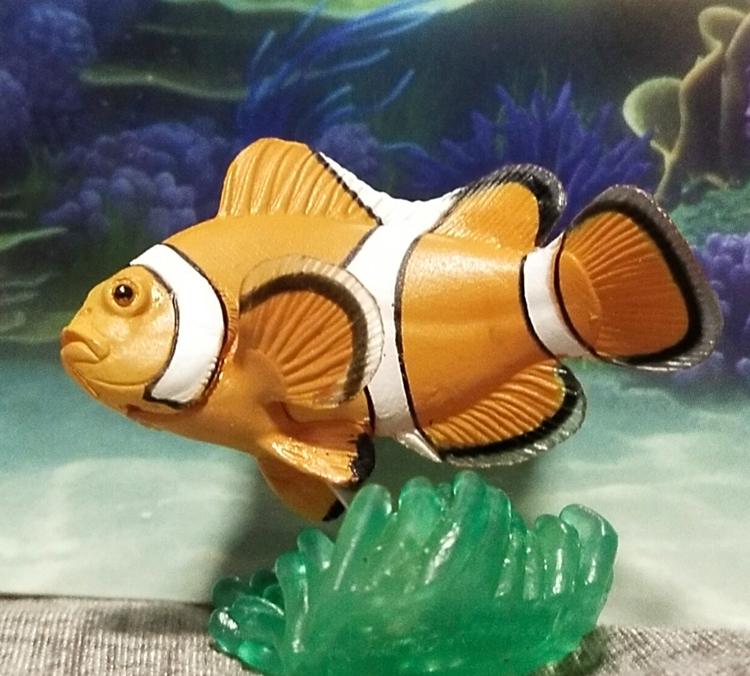

Moorish idol (Zanclus cornutus) and blue regal tang (Paracanthurus hepatus)
Notes: as both figures have already been reviews by me here and here, I will not go into too much details into them.
- Species frequency in being made into toy form: rare for Moorish idol and uncommon for blue tang.
- Base: both have a sandy base with a rock.
- Notes: both figures are included as the major characters in the Finding Nemo movie, with the Blue tang getting its own movie.
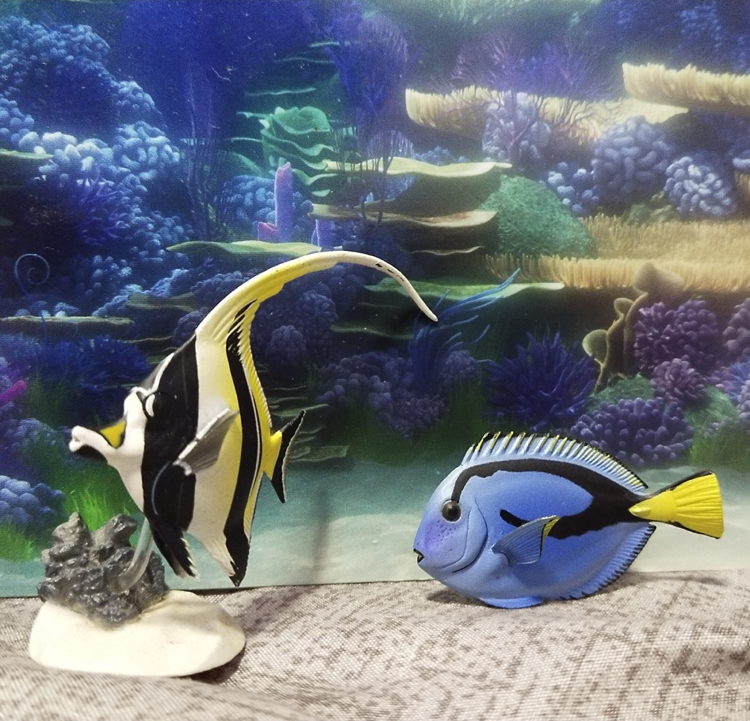
Whitetail Dascyllus (Dascyllus aruanus)
- Size of figure: 4.8vcm
- Size of actual animal: 5-10vcm
- Scale: in the 1:1-1:2 scale range
- Color: white with vertical black stripes, dark grey eye with black pupil, translucent fins (black pectoral and white caudal fins)
- Diet: zooplankton
- Species frequency in being made into toy form: Unique
- Base: sand with live rock
- Notes: One of the few times a fish within the family Pomacentridae being made into figure form that isn’t an ocellaris clownfish. A common species in aquaria, especially for beginners; more experienced keepers tend not to like these fish due to their aggressive tendencies as adults. The figure is based on the three-striped damsel due to the white tail and shape of the dorsal fin. There is also a secret blue devil damselfish that reuses this sculpt.
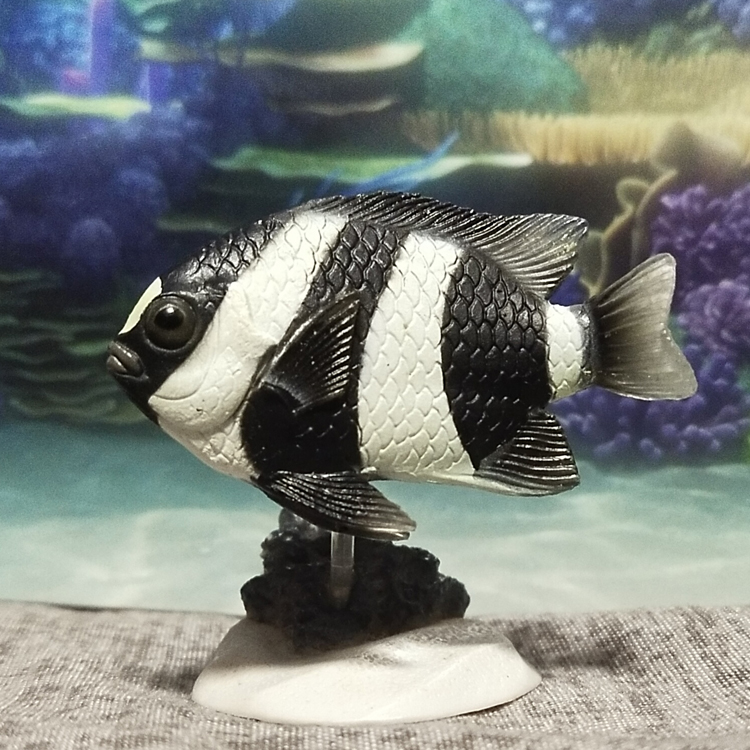
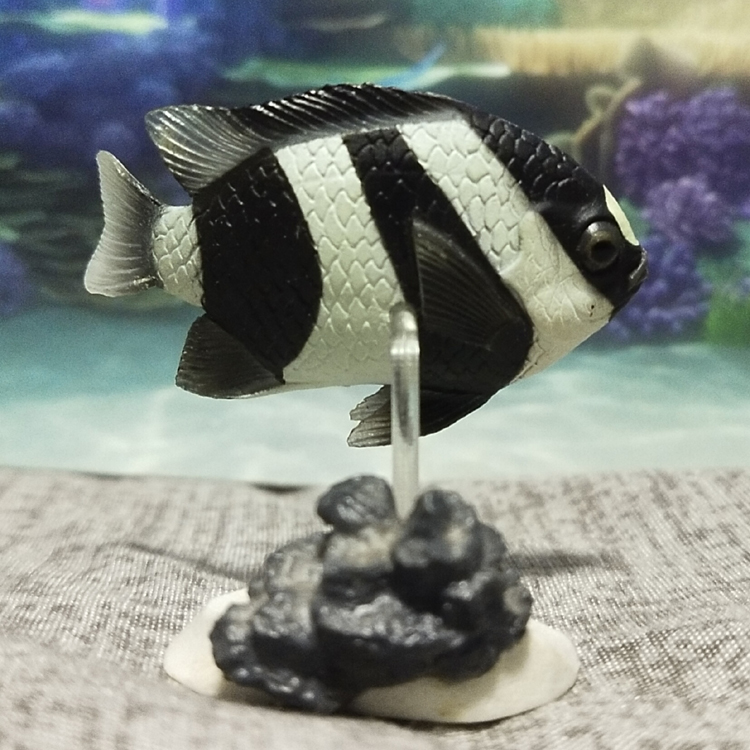
Yellow Tang (Zebrasoma flavescens)
- Size of figure: 5 cm
- Size of actual animal: 20 cm
- Scale: 1:4
- Color: uniform yellow body, brown eyes with black pupils, brownish gill cover, translucent yellow pectoral fins and white tail spine
- Diet: algae and other marine plants
- Species frequency in being made into toy form: very rare
- Base: sand with live rock
- Notes: One of the only 2 tang species that has been made into proper figure form due to its popularity in the aquarium hobby. This figure looks to be sculpted off a large adult and the fins are at rest, which will be erect like a sail when threatened, hence another common name, yellow sailfin tang. This figure has a lateral line sculpted down the body, similar to the real fish. Also, like other members of its family, it has a tail spine sculpted, which is used for defense.

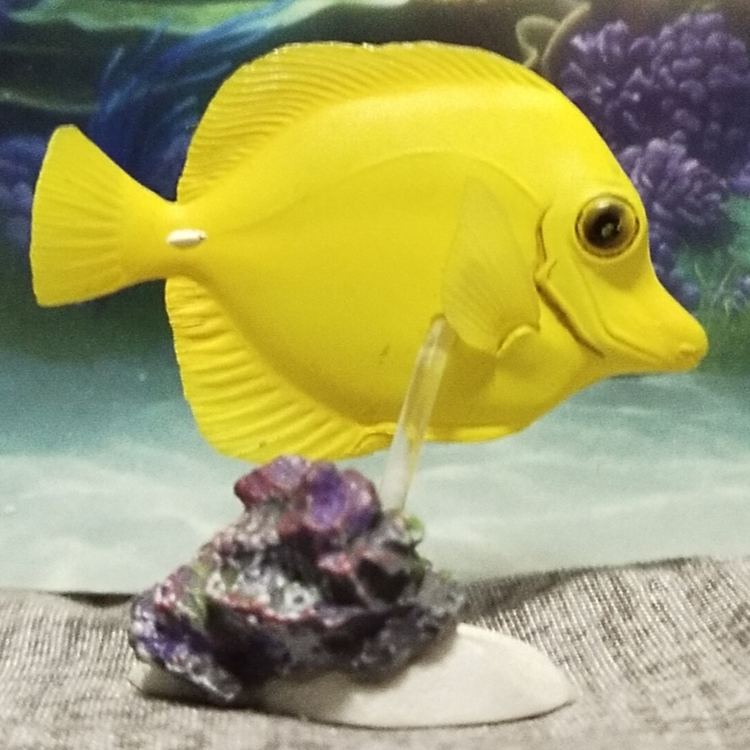
Royal gramma (Gramma loreto)
- Size of figure: 5.2 cm
- Size of actual animal: up to 8 cm
- Scale: about 1:1.5
- Color: purple front half with yellow back half, blue eye with black pupil
- Diet: zooplankton and phytoplankton
- Species frequency in being made into toy form: unique
- Base: rocky base
- Notes: the only time a basslet has been made into figure form and the only species in the set not known from areas around Japan, but possibly added because the species was inspired from the character Gurgle, who is a germaphobe royal gramma. The figure seems to be one of the larger one in the set, ironic because it’s the smallest species featured in the set. There is a black spot on the front half of the dorsal fin and a brown streak running down the eye of this figure.
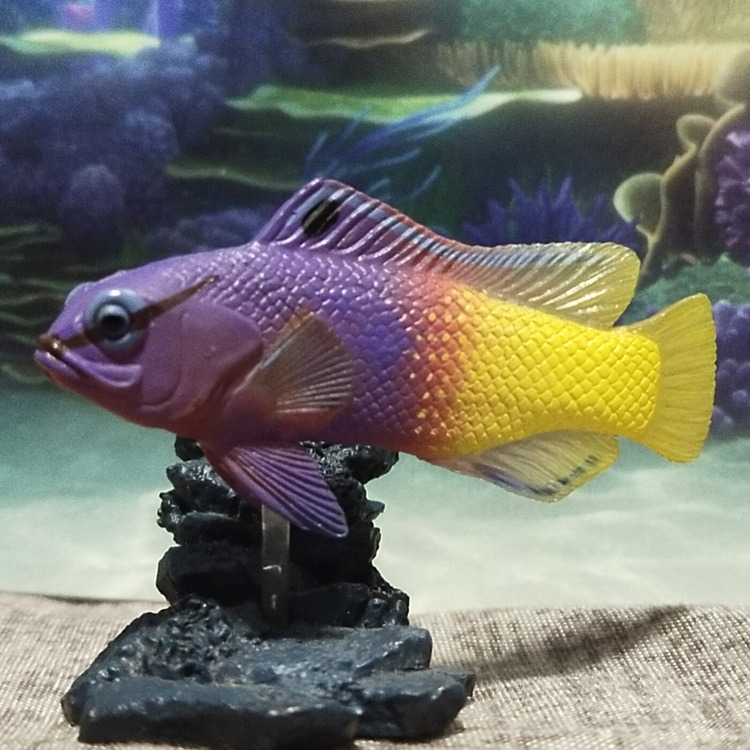

Long-spine Porcupinefish (Diodon holocathus)
- Size of figure: 5 cm
- Size of actual animal: 25-50 cm
- Scale: 1:5-1:10
- Color: tannish top with white belly, translucent tan fins with black spots throughout body and brown streak down both eyes
- Diet: Crustaceans, mollusks, bivalves, urchins
- Species frequency in being made into toy form: very rare
- Base: rocky base
- Notes: This figure is obviously sculpted puffed up, for which is what the genus is known for, unlike the Kaiyodo one which is sculpted deflated. This species has about 350 spines which are modified scales, but I doubt that there are actually 350 spines sculpted on such a small figure. The spines are relatively sharp, so do be careful! This is the hardest and most expensive of the fish in the entire set to obtain, usually running for about 100 dollars, due to it being not re-released in other sets like the special assortment or the Toba Aquarium assortment. This is one figure that I have been hoping to get for over a decade!
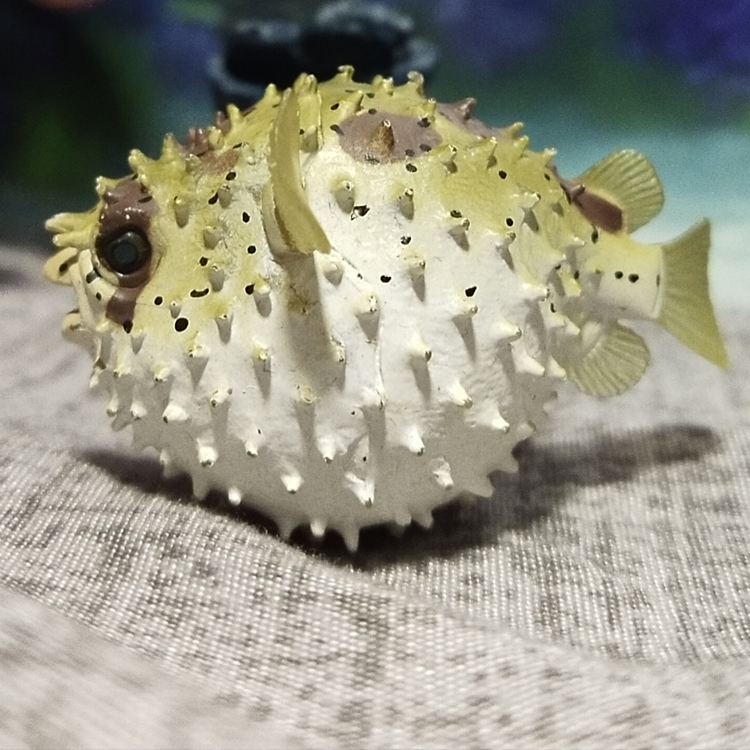
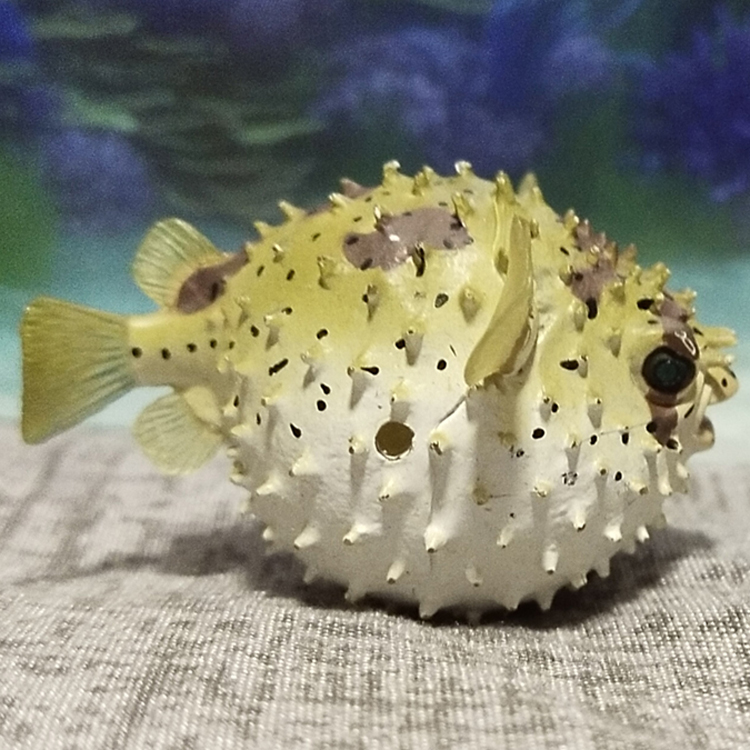
That is it for the first part of this review. Stay tuned for part 2!

Disclaimer: links to Ebay and Amazon on the AnimalToyBlog are affiliate links, so we make a small commission if you use them. Thanks for supporting us!



